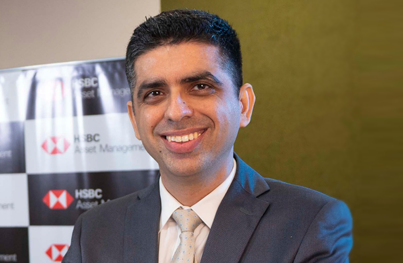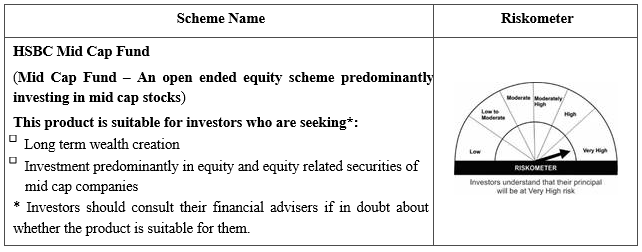We want to invest in businesses that we believe will grow their earnings at a rapid pace
BFSI Industry Interview

Mr. Ankur Arora is a Senior Vice President and Fund Manager - Equities in the onshore India Equity Team. Ankur brings with him more than 16 years of experience spread across fund management, research and strategy. Prior to joining HSBC, Ankur has worked with Aegon Life Insurance, Arvind Ltd, IDFC Asset management, ING Investment Management, Macquarie Securities, Evalueserve and UTI Asset Management in various capacities. A management graduate from of Indian Institute of Management, Lucknow, Ankur also holds a CFA from CFA Institute and a B. Com from Guru Nanak Dev University. Amritsar.
What is your outlook on the Indian economy in the post COVID scenario?
Covid has been a big disruption for every major global economy and India was no exception. India's GDP growth rate fell sharply last year on account of lockdowns that were imposed to control the spread of Covid-19. However, since then market has seen a phase of restoration with GDP growth returning back to positive. We are optimistic on the current growth trends and expect economy to grow at rapid pace in the coming years. There are multiple factors supporting this expansion. A few important ones are expansionary policies of the central government, low interest rate scenario in the country today and strong global growth that is helping exports from the country. In addition, India continues to receive huge amount of FDI into the country that provide additional fillip to the growth. Given these tailwinds, we remain constructive on future growth.
You are launching a midcap fund. The Nifty Midcap 150 index has seen a strong rally in the last one year. Are you concerned about valuations in this segment?
One needs to look at valuations in conjunction with the growth a business is witnessing. Corporate earnings have grown at single digit growth rate annually over the last decade and the valuations over the last decade was based on this relatively low growth rate scenario. However, the current consensus estimates point to a strong earnings growth for midcap companies. In addition, the cost of capital currently is close to a decadal low. The current valuation in the market reflect this higher growth expectation and low cost of capital scenario. We don't believe looking at valuation in isolation is the best way to look at attractiveness of the market but rather one should look at them from prism of growth and low cost of capital scenario we are in. Keeping those factors in mind, we don’t believe there is big cause of concern as far as valuations are concerned.
Please describe the salient features of your midcap fund. What will be your investment style in this fund - growth, value or a combination of both? Also, please describe your investment strategy - will it be top down or bottom up?
We are optimistic on the growth that our economy is likely to witness in the coming years. In line with that our portfolio will also have a growth orientation. We want to invest in businesses that we believe will grow their earnings at a rapid pace. Now these ideas will primarily come from our bottom up analysis which will have an overlay of our macro view. As the focus of the fund is investing in quality fast growing midcaps, we need to be evaluating every investment opportunity individually and to that extent our portfolio will primarily be built with both top down and bottom up stock ideas.
Midcap stocks have presence in sectors where large caps do not have any presence. Do you see high revenue and earnings growth potential in some of these sectors?
Midcap stocks offer more diversified universe for Investment than large cap. We believe there are opportunities available across many sectors that find little space in large cap indices. To that extent we have an opportunity to invest into more diversified themes vis-à-vis large caps. Many of these additional sectors have a very large opportunity size which many midcaps companies are taking advantage of and continue to grow at a rapid pace. We are excited by this opportunity and definitely see midcap companies being big gainers there.
Well managed midcap funds have historically been wealth creators for investors. What is your process for identifying midcap stocks that can generate alphas and create wealth for investors?
We are following a 4Q approach to choose the midcap stocks in our portfolio which are
- Quality of Business,
- Quality of Management,
- Quality of Earnings, and
- Quantum of Earnings.
These 4Qs help us in identifying and evaluating the midcap companies in a structured manner. First thing we look at is the Quality of Business i.e business should be scalable, the company should be relevant in the industry it operates in, regulatory hurdles should be limited, etc. Two - it should have good quality management as indicated by their historical track record, their capital allocation decisions, etc. Three - the company should have good quality of earnings as defined by RoCE profile, cash flow conversion, consistency in earnings etc. and Four - Quantum of Earning by which we mean that it should be increasing its profit by large quantum. We believe companies that display these four characteristics are the one that would be leading the growth cycle that is there in front of us and will be able to generate alpha for the investors.
For the benefit of investors, please describe in brief the process of your in-house research for midcap stocks.
We have a robust investment process that our in-house research team uses to identify the investible ideas for a portfolio. In the first phase the stocks are screened based on their sustainable earning growth. From there, the team analyse these screened ideas from the prism of quality. Each idea is evaluated based on factors such as their competitive advantage, management track record, capital allocation decisions, return profile, etc. We actively gauge the ESG impact to mitigate risks and capture opportunities. And then a composite valuation framework is used to ascertain the fair value of a stock.
Is this a good time to invest in midcaps with a long term investment horizon? What is the minimum recommended investment horizon for investors who may be looking to invest in your midcap fund? Please share your views.
We believe many midcaps of today have the opportunity and ability to grow at a rapid pace and become large caps of tomorrow. They are on a journey to become much larger players in their respective segments as long as they execute well and capture the opportunity that the strong economic growth cycle is providing. Typically, maximum returns are generated when investment period coincides with the evolution of the business till it becomes stable. Since, the time period for the stability of businesses should come in 5-7 years, an investment horizon should also have the same time frame.
Product Labelling: To provide investors an easy understanding of the kind of product / scheme they are investing in and its suitability to them, the product labelling is as under:

Product labelling assigned during the NFO is based on internal assessment of the scheme characteristics or model portfolio and the same may vary post NFO when the actual investments are made.
Mutual fund investments are subject to market risks, read all scheme-related documents carefully.
The above information are for illustrative purpose only and it should not be considered as investment research, investment recommendation or advice to any reader of this content to buy or sell investments. Various index and their constituents and other stocks discussed in this document are for illustrative purpose only for explaining the concepts stated in this presentation and it should not be considered as investment research, investment recommendation or advice to any reader of this content to buy or sell investments. From the asset allocation perspectives, the Scheme shall invest minimum 65% of AUM in those mid cap stocks which meets the criteria of Mid Cap Stocks as defined by SEBI i.e. 101st to 250th stock in terms of total market capitalization of the stock.
This document has been prepared by HSBC Asset Management (India) Private Limited (AMIN) for information purposes only with an intent to provide market overview and should not be construed as an offer or solicitation of an offer for purchase of any of the funds of HSBC Mutual Fund. All information contained in this document (including that sourced from third parties), is obtained from sources, which AMIN/ third party, believes to be reliable but which it has not been independently verified by AMIN/ the third party. Further, AMIN/ the third party makes no guarantee, representation or warranty and accepts no responsibility or liability as to the accuracy or completeness of such information. The information and opinions contained within the document are based upon publicly available information and rates of taxation applicable at the time of publication, which are subject to change from time to time. Expressions of opinion are those of AMIN only and are subject to change without any prior intimation or notice. It does not have regard to specific investment objectives, financial situation and the particular needs of any specific person who may receive this document. Investors should seek financial advice regarding the appropriateness of investing in any securities or investment strategies that may have been discussed or recommended in this report and should understand that the views regarding future prospects may or may not be realized. Neither this document nor the units of HSBC Mutual Fund have been registered in any jurisdiction. The distribution of this document in certain jurisdictions may be restricted or totally prohibited and accordingly, persons who come into possession of this document are required to inform themselves about, and to observe, any such restrictions.
This document is intended only for those who access it from within India and approved for distribution in Indian jurisdiction only. Distribution of this document to anyone (including investors, prospective investors or distributors) who are located outside India or foreign nationals residing in India, is strictly prohibited. Neither this document nor the units of HSBC Mutual Fund have been registered under Securities law/Regulations in any foreign jurisdiction. The distribution of this document in certain jurisdictions may be unlawful or restricted or totally prohibited and accordingly, persons who come into possession of this document are required to inform themselves about, and to observe, any such restrictions. If any person chooses to access this document from a jurisdiction other than India, then such person do so at his/her own risk and HSBC and its group companies will not be liable for any breach of local law or regulation that such person commits as a result of doing so.
© Copyright. HSBC Asset Management (India) Private Limited 2021, ALL RIGHTS RESERVED.
HSBC Asset Management (India) Private Limited, 9-11 Floors, NESCO IT Park, Building no. 3, Western Express Highway, Goregaon (East), Mumbai – 400 063, India.
Email: hsbcmf@camsonline.com | Website: www.assetmanagement.hsbc.co.in
Recent Interviews
-
Partner Connect by Advisorkhoj with Mr Amit Kalra Glorious Path Pvt Ltd New Delhi
Dec 5, 2025
-
Partner Connect by Advisorkhoj with Mr Alok Dubey PrimeWealth Pune
Dec 1, 2025
-
In Conversation by Advisorkhoj with Ms Aparna Shanker Chief Investment Officer Equity The Wealth Company Mutual Fund
Nov 28, 2025
-
In Conversation by Advisorkhoj with Mr Sanjay Bembalkar Head Equity Union MF
Nov 28, 2025
-
In Conversation by Advisorkhoj with Mr Arjun Khanna Equity Fund Manager Kotak Mutual Fund
Nov 17, 2025
Fund News
-
DSP Mutual Fund launches DSP Nifty Next 50 ETF
Dec 19, 2025 by Advisorkhoj Team
-
DSP Mutual Fund launches DSP Nifty 500 Index Fund
Dec 19, 2025 by Advisorkhoj Team
-
Kotak Mahindra Mutual Fund launches Kotak Nifty Next 50 ETF
Dec 18, 2025 by Advisorkhoj Team
-
The Wealth Company Mutual Fund launches The Wealth Company Gold ETF
Dec 16, 2025 by Advisorkhoj Team
-
Axis Mutual Fund launches Axis Gold and Silver Passive FOF
Dec 10, 2025 by Advisorkhoj Team





